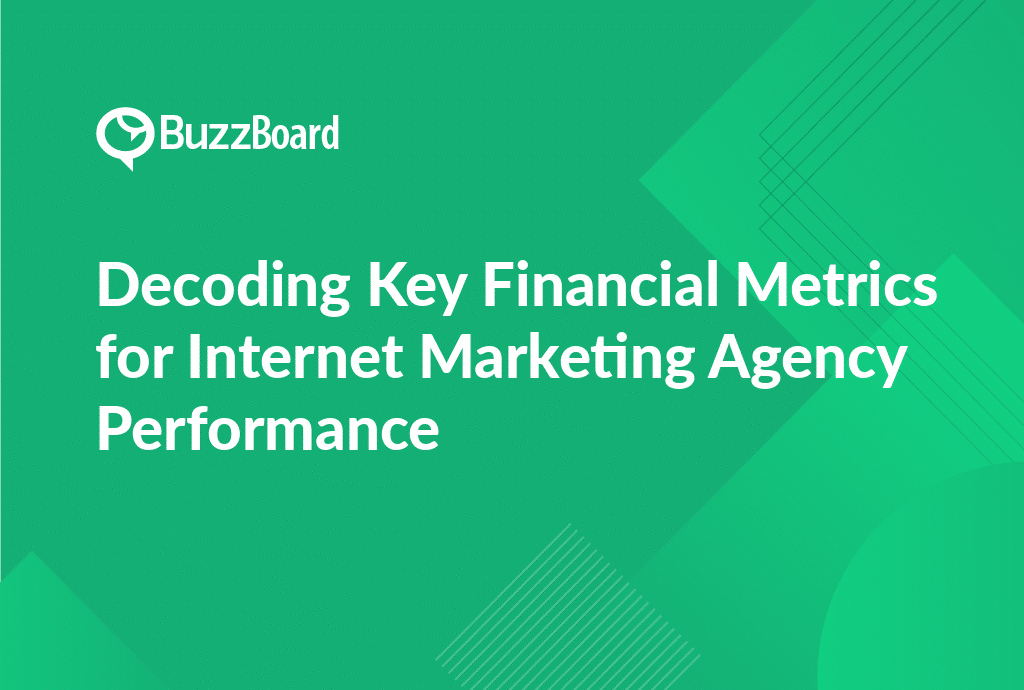Understanding the Role of Key Financial Metrics in Assessing the Performance of Your Internet Marketing Agency
In the rigorous landscape of internet marketing, a profound understanding and utilization of critical financial metrics are essential in evaluating and enhancing your agency’s overall performance. As a knowledgeable sales representative, awareness of these metrics can facilitate agency growth, improve client relationships, and guarantee consistent business sustainability.
Crucial financial metrics for internet marketing agencies predominantly involve cash flow, cost per acquisition (CPA), monthly recurring revenue (MRR), and lifetime value of a customer (LTV). Firm comprehension of these financial elements assists in making well-informed decisions, boosting profits, and refining financial monitoring mechanisms within the agency.
In detail, cash flow signifies the movement of money into or out of your business, providing a comprehensive depiction of the agency’s monetary health. Conversely, CPA aids in deducing the profitability of individual online advertising campaigns. Grasping the cost of acquiring a new customer versus the customer’s LTV empowers strategic investment of marketing resources.
MRR is particularly vital in evaluating an agency’s stability and growth. It provides insight into the regular income expected from current contracts. Lastly, understanding a customer’s LTV allows agencies to project potential revenue over time, thereby enabling effective business growth strategies.
Ultimately, mastering the comprehension of these financial metrics can vastly improve agency performance, resulting in attracting more clients and maintaining a robust market position. Begin utilizing these financial monitoring tools today to alter your agency’s growth pattern.
Bear in mind, your knowledge of these financial metrics directly impacts not just your individual performance, but the broader success of your agency. Embrace them!
How Can Accurate Financial Monitoring Improve Your Internet Marketing Agency’s Business Growth?
Developing a systematic approach to financial monitoring is crucial for the sustainable growth of your internet marketing agency. Key financial metrics can offer insights into your agency’s performance, enabling you to make informed decisions and strategic adjustments.
Key financial metrics for internet marketing agencies often include cash flow, profitability, client acquisition cost, and return on investment (ROI). Monitoring cash flow can alert you to potential financial vulnerabilities that can inhibit business growth. Profitability measures can help identify which services or clients are more profitable and where to focus resources. Understanding your client acquisition cost allows for effective allocation of your marketing budget, which in turn, improves your ROI.
Additionally, financial monitoring can highlight opportunities for business expansion. If your agency is consistently generating positive cash flow and high profitability, it may be time to consider scaling your business—whether by expanding your team, investing in new software, or acquiring smaller agencies.
However, financial metrics should not be viewed in isolation. They should be analyzed with other key performance indicators (KPIs) to gain a holistic view of agency performance. By effectively utilizing these metrics and tracking them over time, internet marketing agencies can make strategic decisions that fuel sustainable growth.
Remember, a proactive approach to financial monitoring can significantly impact an internet marketing agency’s trajectory. Harness the power of key financial metrics to drive your agency’s business growth.
Discover the Critical Financial Metrics That Define the Performance of Successful Internet Marketing Agencies
In digital marketing, comprehending your financial metrics is critical to assessing your agency’s overall health and success. It’s imperative for sales representatives in digital marketing agencies to plunge into these vital financial metrics, which directly influence agency performance, financial surveillance, and stimulating business expansion.
Client Acquisition Cost (CAC) is a vital financial metric. It quantifies the expense of acquiring a new client, assembling all costs incurred in sales and marketing. By grasping and diminishing your CAC, you can augment profits and productivity in your agency.
Another financial metric worth noting is the Client Lifetime Value (CLV). The CLV metric is crucial as it illustrates the estimated revenue a client will contribute to your agency throughout their customer lifecycle. By comparing CAC to CLV, your agency can assess the viability and profitability of maintaining long-term client relationships.
The Revenue Growth Rate directly signifies your success in attracting new clients and preserving existing ones. Monitoring this metric is essential for understanding agency performance and tracking annual financial growth.
Routine financial oversight of these critical metrics empowers digital marketing agencies to evaluate current performance and strategize future growth. Financial metrics ultimately guide your business decisions and adaptations to market changes.
Remember, knowing your numbers is the foundation for understanding your agency’s financial health and solidifying sustainable growth. The right insights can revolutionize your business results.
Identifying and Interpreting Crucial Financial Metrics for Optimal Agency Performance in the Online Marketing Sector
In the dynamic digital landscape, key financial metrics highlight potential success for internet marketing agencies. Understanding these metrics can illuminate agency performance and fuel sustainable business growth.
Consistent financial monitoring must be done regularly and systematically. It aids in identifying potential opportunities and threats. With the help of these financial metrics, agencies can monitor their fiscal health and establish newer, higher benchmarks for revenue growth.
Five key financial metrics crucial for agency performance in online marketing include gross profit, net profit, profit margin, client concentration, and cash flow. Gross profit helps gauge the profitability of your services. Net profit indicates profitability after all expenses have been deducted. The profit margin shows the percentage of profit per dollar earned. Client concentration identifies the risk level if a major client discontinues the services. Lastly, cash flow, a pivotal metric, maintains the agency’s financial stability.
Aligning these financial metrics with your business strategy can provide a competitive edge and kickstart your agency’s growth. Understanding the complexities of financial monitoring helps solve business ambiguities and convert them into growth opportunities.
Remember, understanding key financial metrics equips you with the tools to flourish in the ever-evolving online marketing world and yield optimal agency performance.
Key Financial Practices for Internet Marketing Agencies: A Guide to Effective Financial Monitoring and Business Growth Strategies
Key financial practices serve as essential success components for internet marketing agencies, especially those targeting small businesses. A thorough examination of key financial metrics for these agencies leads to insights that improve agency performance and spur business growth.
First, a robust financial monitoring system enables agencies to track crucial metrics like revenue, cash flow, and overhead costs. This information offers a detailed picture of financial health, supports decision-making, and flags potential risks early.
Second, agencies must understand and monitor the client’s lifetime value (CLV). This crucial metric represents the total income an agency can realistically expect from a single client account—an important measure of customer retention and revenue potential.
Similarly, it’s vital to monitor the client acquisition cost (CAC). A lower CAC increases profitability, as it directly impacts an agency’s ability to invest in new customer acquisition. The cost per lead (CPL) is another key financial metric that helps agencies measure their investment in every acquired lead.
Grasping these critical financial metrics is the first step towards devising an effective business growth strategy appealing to small and local businesses. Regular metric monitoring enables agencies to reaffirm their strategies and adjust to changing client needs.
Ready to jumpstart your growth journey? Always remember, knowing the numbers is integral to catalyzing business growth.









